Covermark
The Covermark line of cosmetics was developed because its founder, Lydia O’Leary, suffered from a large, raspberry-coloured birthmark – a port-wine stain or nevus flammeus – that covered half of the left-hand side of her face. She developed Covermark to ‘cover this mark’ and in doing so introduced the world to new classes of cosmetics.
See also: Corrective Make-up (Concealers)
Lydia was one of six children born in 1900 in Bedford, Massachusetts to Henry and Hannah O’Leary. After attending high school she enrolled at the Fitchberg Normal School for Teachers, graduating in 1921. She then worked as a teacher for two years before moving to New York to work in retail. Unfortunately, according to legend, her attempts to get a sales job in any of the city’s department stores were rebuffed by job interviewers, who thought her facial disfigurement made her unsuitable for work with the general public.
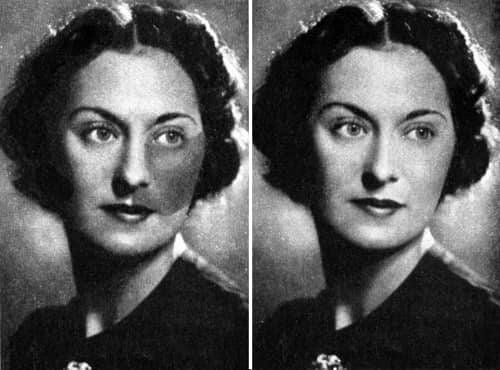
Above: 1936 Lydia O’Leary without and with Covermark.
Exactly how she came to use make-up to cover her birthmark is an open question. One story suggests she got the idea while working as a placard painter, a job she took up after failing to get work as a sales assistant. According to this tale, after fixing a mistake by overpainting it, O’Leary wondered if she could cover her birthmark in the same way. The account may be a quaint fiction but it gets some support from the fact that the original Covermark was developed as a lotion and applied with a brush. However, given that make-up was widely available in New York in the 1920s, it seems extremely unlikely that O’Leary did not first try covering her skin blemish with make-up or greasepaint, and only moved on to making something of her own after discovering that nothing suited her particular needs.
Formulation
The product O’Leary formulated – with the help of a chemist – was not without precedent. It had similarities with Wet White – a stage make-up that was also popular for whitening the neck, arm and hands in the nineteenth century – and Calamine Lotion, a widely used medicinal.
Wet White and Calamine Lotion are both liquid preparations made primarily of zinc, glycerine and water. These ingredients were also used by O’Leary to formulate the original Covermark Lotion but as she needed a lotion with more covering power, she mixed them in different proportions. To work as a blemish cover her mixture needed to contain sufficient zinc to cover skin defects, but not so much that the mixture would lose flexibility, causing it to crack or flake. It was only after considerable trial and error that a suitable formulation was found. The initial product was a liquid powder but she soon switched to a cream which gave a better coverage.
The proportion of the ingredients and the manner of compounding the same are preferably as follows: I take 2041 grams of the zinc powder (U.S.P.), or it may be zinc powder in some other form, as silicate of zinc (calamine); 720 cubic centimeters of distilled water and 300 cubic centimeters of glycerine and mix them thoroughly together for about ten minutes in a mortar with a pestle.
(U.S. Patent: 1877952)
See also: Liquid Face Powders
The base mixture was white but by adding pigments O’Leary could create a range of colours to match different skin tones. Given the shades she developed, it seems clear that she only had people with lighter skins in mind.
Flesh: Very Pale—Use only on unexposed parts of the body and for evening wear.
Pink Medium: Like Rachelle, but tending toward pinkish cast. Good for most redheads and very fair skins.
Tan Medium: A Real Rachelle Shade.
Dark Olive: A Darker Rachelle Shade containing more yellow.
Peach: Combination of Pink and Yellow tones—Very good for blemish on the face, chin and nose.
Brunette: Good for light sun tan … very yellow.
Dark: A deep Pinkish Peach, mostly used by men and women with ruddy complexions.
Sun Tan: A Reddish Tan Shade for summer sun tan.(O’Leary, 1936)
Also see the booklet: A Modern Miracle (1936)
Patent
The simple formula of Covermark was easy to copy so O’Leary attempted to protect it with a patent. Her application was denied by the U.S. Patent Office but fortunately for O’Leary a bit of theatrics at the Court of Appeals – during which she removed her make-up so that the judges could see its effect – created such an impression on the bench that her patent (US1877952) was granted in 1932.
Early developments
By 1930 – at which time O’Leary describes herself as a department store buyer – she had developed the Covermark Lotion and was offering treatments through her apartment at 651 East Third Street, Pelham, New York before moving to a studio at 11 West 42nd Street. Individuals would have been referred to her through friends, from dermatologists, or by word of mouth.

Above: Covermark Lotion and brush.
Although she made a good deal of money from Covermark, O’Leary set high standards for her product and, as far as was possible given the technologies of the time, her product lived up to most expectations.
The object of this invention is to provide a dermal preparation to be used to cover an conceal birthmarks and other skin blemishes and to simulate the adjoining or unblemished portion of the skin in texture, flexibility and other purely physical qualities characteristic of the normal skin, and also in color quality on the application to the preparation of a pigment appropriate to the particular type of complexion of the individual treated, and which shall be harness to the skin, avoid discomfort, and be adapted to withstand the presence of water and at least the casual contact of the hands or a handkerchief without being removed or appreciably disturbed.
(U.S. Patent: 1877952)
Achieving the desired result required a good deal of skill to blend the pigments together, so that they covered the blemish and also duplicated the normal light and shade contours of the skin; a complex procedure. To help clients achieve a satisfactory result, where possible O’Leary – and other consultants – conducted an initial treatment to demonstrate to the client how to apply Covermark correctly. This consultation also enabled some colour matching to be carried out so that clients went away with shades that would work for them.
As her business became established, O’Leary began to publicise it more extensively. She made appointments with newspaper and magazine writers in New York and used the ‘reveal and make-up’ trick that had proved so effective in the Court of Appeals to get stories written up about Covermark.
I’ve had one amazing experience this month—probably the most amazing experience any person working in the beauty trade could have. A charming girl called at my office one afternoon. She said she had a new beauty discovery. Having heard that story before I remained calm while she asked me if she could please demonstrate it to me.
Then she set to work and when she finished I was about ready to burst forth into tears. For she changed herself in just a few moments from a beautiful girl to one whose face was badly disfigured with one of those hopeless birthmarks. And then she did some work and transformed herself back once more into the beauty.(Lee, 1931, p 118)
Also see: The Amazing Story of Covermark (c.1932)
By 1936, O’Leary was conducting her business (Lydia O’Leary, Inc.) from a salon at 551 Fifth Avenue and her product range had expanded. The original Covermark Lotion had been removed from sale, replaced by a more functional cream first used in conjunction with the lotion, and a waterproof line had been included.
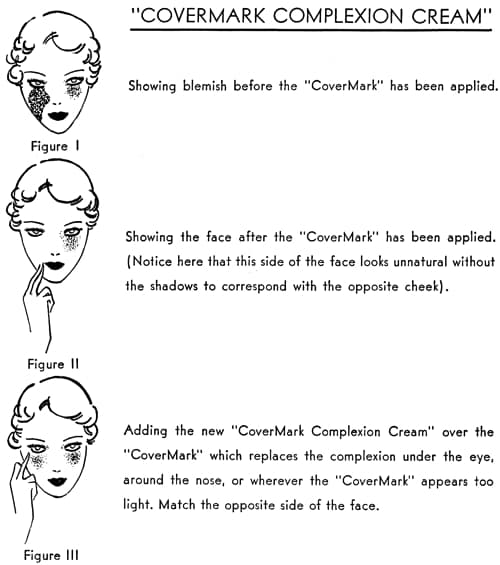
Above: Covermark Complexion Cream applied over the lotion.
Covermark Complexion Cream: “[U]sed to give the face the natural coloring that is concealed when one covers a blemish on the face.” Shades: Flesh, Pink Medium, Tan Medium, Dark Olive, Peach, Brunette, Dark and Sun Tan.
Waterproof Covermark: “[W]ill remain intact throughout the day no matter how wet it becomes. Therefore it is also recommended for blemishes on the hands.” Shades: Light, Medium and Dark.
Covermark Remover: “[D]issolves the Covermark and cleanses the skin without any rubbing. Excellent as a general cleansing cream.”
Thinning Lotion: “The addition of a drop or two of the Thinning Lotion will restore the Covermark to its original state.”
Covermark Spot-Stik: “[F]or the occasional pimple or minor blemish.” Shades: Light, Medium, and Dark.
Special Finishing Powder: “Dries Covermark without changing color. Sets Covermark so that it lasts for hours. Essential for Waterproof Covermark.”
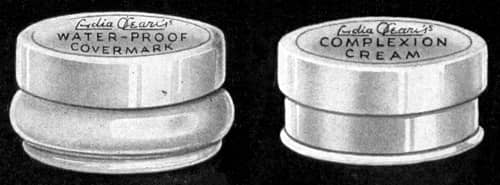
Above: 1936 Water-Proof Covermark and Complexion Cream.
Spot-Stik
Introduced in 1936, this stick product – later known as Spotstik – was an early attempt by O’Leary to widen the reach of her cosmetics. Produced and packaged like a lipstick it was designed to cover small skin blemishes like pimples. As an easy to use concealer that could be carried around in a purse, it predates similar products produced by the majors such as Helena Rubinstein’s Conceal (1942) and Max Factor’s Erace (1954).
Expansion
Through the 1930s, consultants appeared in other cities across America, allowing Covermark products to become more widely available. Overseas distributors were also added, for example, by 1937, she was being marketed in Britain by J. Gaw & Co., later switching to Splendour Ltd., Nottingham.
Introducing Covermark into new territories required training consultants. When Covermark was introduced into Britain the company took out a large advertisement in ‘Chemist and Druggist’ to explain to retailers how its products functioned.
INSTRUCTIONS
A. FOR SMOOTH BLEMISH ON FACE.—Sell CoverMark, Complexion Cream.
1. Start with a clean skin—free of all creams or grease.
2. CoverMark must match the skin surrounding the blemish.
a. If blemish covers one side of face, you must match the skin surrounding the lower part of the jaw-bone.
b. If the blemish is on the forehead, it should match the colouring on the forehead.
c. If the blemish is on the eyelid or directly under the eye, only, take into consideration that in selecting a shade you must remember that the eye-shadow over the eyelid and under the eye is darker than the rest of the skin and select the shade that will cover the blemish and still match the eye-shadow.
3. Use CoverMark like paint, making sure to put on enough so that none of the discolouration shows through.
4. In applying the CoverMark, rub it well into the skin and then gently smooth it over the blemish, taking it an inch beyond the edges of the blemish on all sides . . . We do this so that we can fade the CoverMark into the fair skin, without fading any off the blemish itself.
5. Now take a small amount of the Complexion Cream and rub it into the CoverMark under the eye, over the eye, along the side of the nose and a little under the nose to replace the normal shadows that were covered when the blemish was concealed with CoverMark. This is vitally important, as one will look unnatural if they do not restore the normal shadows.
6. As soon as the application is complete and the edges faded into the skin, immediately PAT on plenty of powder and permit the powder to stay on for about five minutes before PATTING off the excess powder.
7. The powder must match the fair skin surrounding the blemish. If a darker powder is used on the wet base, it will turn the CoverMark much darker and it is advisable to select a neutral tone of powder that will not change the colour of the CoverMark. After the CoverMark has been dried with the powder that matches, a darker powder may then be used if so desired.
8. If rouge is desired, one must use dry rouge. It is very important to keep away from any colour that contains purple, as the purple will bring out the blemish, even through the CoverMark. The dry rouge is applied by first patting on a little powder where the rouge is to be applied, and then very, very gently pat on the dry rouge with a piece of cotton. Do not use the pad that comes in the rouge box, as this is too rough in texture.
9. During the day, as the nose becomes shiny from perspiration, so will the CoverMark, and about every two or three hours, it is necessary to PAT on powder over the entire face and immediately PAT it off again. This dries the CoverMark and settles it for another two or three hours.B. FOR ROUGH AND RAISED BLEMISH ON FACE.
1. In applying CoverMark to a raised blemish, one must remember that the weight of the finger takes the CoverMark off the raised part as one applies it. Therefore, one must follow the above instructions for applying Covermark to a blemish on the face, and then go back and very gently PAT on extra CoverMark where the blemish still shows through.C. FOR ALL BLEMISHES THAT ARE NOT ON FACE.
1. Only CoverMark itself is required, but be sure to use a powder that matches the fair skin to dry the CoverMark.D. COMPLEXION CREAM (same material as CoverMark).
1. Used only on face over the CoverMark to replace the normal shadows that have been covered by the CoverMark. Comes in waterproof form for the Waterproof CoverMark and in greaseless form for the Regular CoverMark.E. ALL-OVER OR EVENING MAKE-UP.
1. CoverMark is unexcelled as an all-over make-up, because once applied it will remain intact until removed and will not flake off. 2. Any colour can be used, for whatever colour one selects, that will be the tone of the skin. Should one desire a pale complexion, the lighter tones are suggested. But if one has a sallow skin, we suggest a peach or the dark shades, which will give to the skin a healthy glow and a wholesome radiance.
3. Take a small amount of CoverMark cream and spread it quickly over the entire area. Powder and rouge over this, but make sure to always PAT on the powder and do not apply the rouge until the CoverMark is thoroughly dry.
4. CoverMark absolutely prevents sun and wind burn, and when wearing CoverMark one will not freckle or tan through it.F. THINNING LOTION.
1. This is not a necessity unless one has let the CoverMark become thick at the base of the jar. The addition of a drop or two of the Thinning Lotion will restore the CoverMark to its original state. Used only with regular CoverMark.G. REMOVING COVERMARK.
1. CoverMark is removed with CoverMark Remover or any good liquefying cleansing cream.H. COVERMARK SPOT-STIK.
Whereas CoverMark Cream has been prepared especially for concealing large blemishes, the SPOT-STIK is for the occasional pimple or minor blemish. Apply enough Spot-Stik to cover pimple or small mark. DO NOT RUB. Merely PAT the edges into the fair skin and dry with powder. The Spot-Stik is waterproof. Three shades: Light, Medium and Dark.I. LEUCODERMA AND VITILIGO (Brown and White Patches).
Leucoderma and vitiligo are the most common blemishes and are more prevalent in the warm months. When choosing your shade, do not make the mistake of trying to make the light spots dark. One should select a shade that matches the general colouring of the skin, and cover BOTH the brown and white spots at the one time. It is the brown area that needs more CoverMark. CoverMark is excellent for this purpose, for it not only covers the spots but protects the skin from wind and sun, thus preventing the pigment from spreading further.(Covermark trade advertisement, 1937)
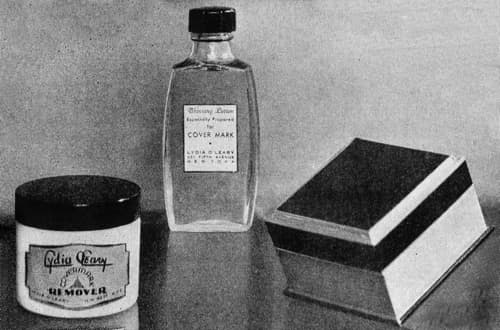
Above: Covermark Remover, Thinner and Finishing Powder.
In addition to being used on serious skin blemishes like birthmarks, x-ray burns, varicose veins and vitiligo, O’Leary advertised her product as being suitable for broken veins, dark circles under the eyes and other minor blemishes. This made Covermark the first commercial product specifically designed as an all-purpose concealer.
Cosmetic line
Although the core of the Covermark business remained in what we would now call camouflage make-up, O’Leary diversified her product line. In 1948, she announced to the trade journal ‘American Perfumer & Essential Oil Review’ that she was going to introduce a cosmetic line and, from 1949, she began to sell a number of Lydia O’Leary Beauty Aids including: Face Powder, Camellia Cream and Lotion, Foundation Cream, Cleansing Cream, Skin Freshener, L.O.L. medicated skin lotion, cream and cake rouge, and lipsticks.
Later developments
A number of firms currently claim ownership of the Covermark trademark and associated intellectual property. Unfortunately, I have been unable to completely sort out the details of the various arrangements. The original company now appears to be branded CM-Beauty after having gone through a number of owners. In Asia, Covermark cosmetics are manufactured and distributed by Covermark Japan, established in 1960 but made independent in 1992. It currently markets Covermark to Thailand, Mainland China, Hong Kong, Taiwan and Singapore. Farmeco SA Dermocosmetics, a European company founded in 1977, is a third Covermark company, having acquired the rights to a number of Covermark markets outside of the United States in 1994. Each branch of the Covermark family seems to have independently updated its specialist blemish concealers and built up a range of more general cosmetics.
See also: Corrective Make-up (Contouring)
Timeline
| 1928 | O’Leary develops Covermark Lotion. |
| n.d. | Lydia O’Leary, Inc. founded in New York. |
| 1931 | O’Leary begins commercial sales of Covermark. |
| n.d. | Lydia O’Leary incorporates. |
| 1932 | Patent for Covermark granted. |
| 1936 | New Products: Covermark Spot-Stik. |
| 1937 | Covermark distributed in Britain. |
| 1948 | Lydia O’Leary announces plans to introduce a cosmetic line. |
| 1953 | New Products: L.O.L. lotion. |
| 1960 | Japan O’Leary Corporation established in Japan. |
| n.d. | Lydia O’Leary, Inc. acquired by Roberts Proprietaries, Inc. and becomes a division within that organisation. |
| 1992 | Japanese firm becomes independent as the Covermark Corporation and begins to produce its own make-up products. |
| 1994 | Farmeco S.A. Dermocosmetics acquires the International distribution of Covermark (does not include the United States, Japan and few other Asian markets owned by Covermark Japan). |
First Posted: 8th October 2012
Last Update: 8th November 2020
Sources
The American perfumer & essential oil review. (1906-1955). New York: Robbins Perfumer Co. [etc.].
Lee, M. (1931). The truth about cosmetics. Screenland. May, 102, 118.
O’Leary, L. (c.1932). The amazing story of Covermark [Booklet]. U.S.A.
O’Leary, L. (1936). The modern miracle [Booklet]. U.S.A.
White, P. (1936). Modern miracle. Readers Digest. 28(170), 8-11.
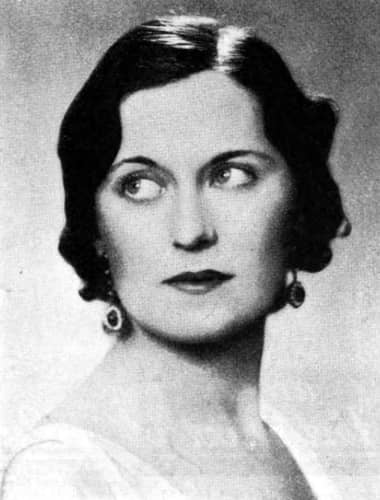
Lydia O’Leary [1900-1982]. In her late forties she married James Reeves [1871-1957] who, with his brother Daniel, had built up a chain of grocery stores before selling out to Safeway, Inc. in 1941 and retiring. At the end of her life she resided at 740 Park Avenue, a luxury apartment building in Manhattan.

1931 The original Cover Mark Lotion and brush.
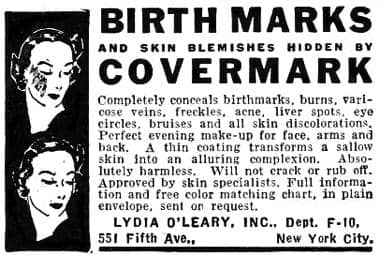
1935 Covermark.
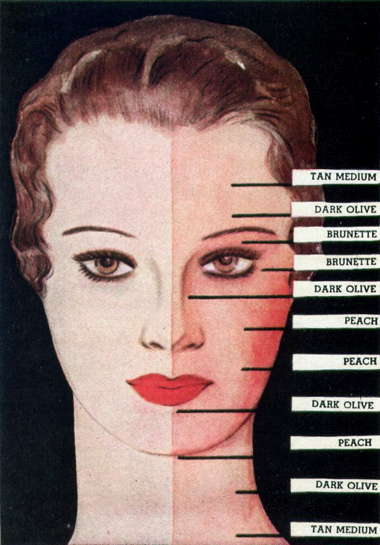
1936 Covermark Chart for a Brunette. A cream is now being used rather than a lotion. Following this scheme to create a natural looking face with contours required time, patience and practice.
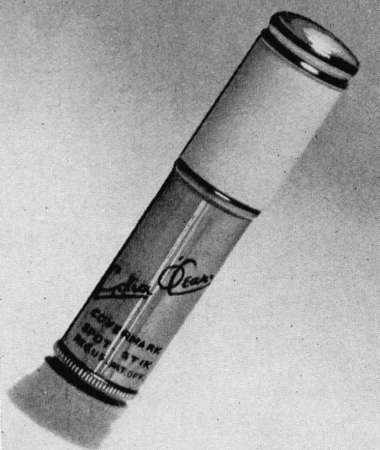
1936 Spot-Stik, the first stick concealer.

1938 Covermark Spot-Stik.

1939 Spot-Stik as distributed in Britain by Splendor, Ltd. Nottingham.

1945 Covermark Spot-Stik.

1947 Covermark.
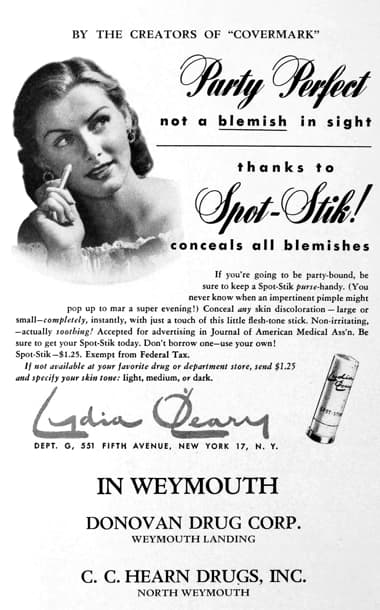
1947 Spot-Stik.

1949 Covermark. O’Leary is using Max Factor’s four colour groups: Blondes, Brunettes, Redheads and Brownettes.
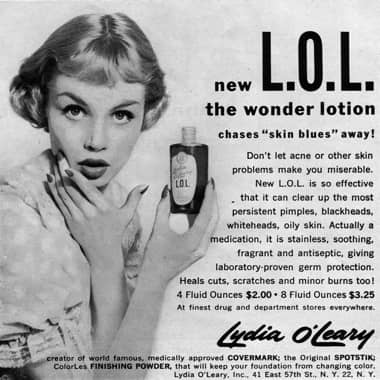
1956 L.O.L. lotion. It contained a range of medications including organic sulphur oil, resorcinol, hexachlorophene and eugenol. I assume the product is named after her initials.
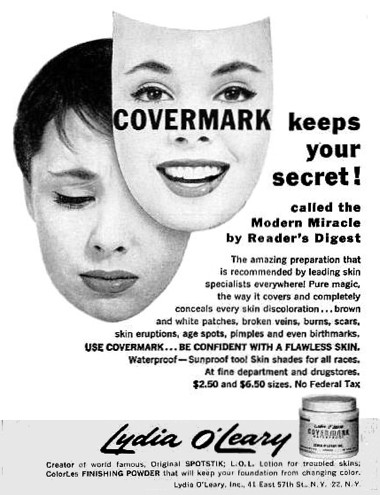
1956 Covermark.

1956 Spotstik.
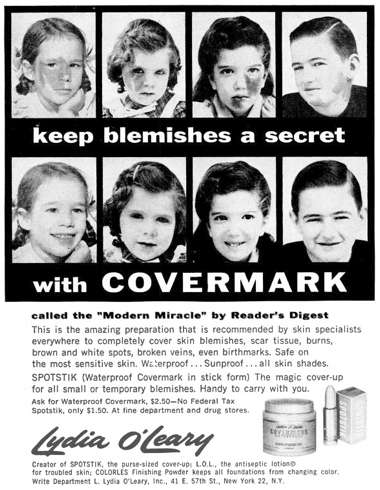
1958 Covermark Cream and Spotstik.

1980 Covermark used on a ‘port wine stain’.

1982 Covermark.
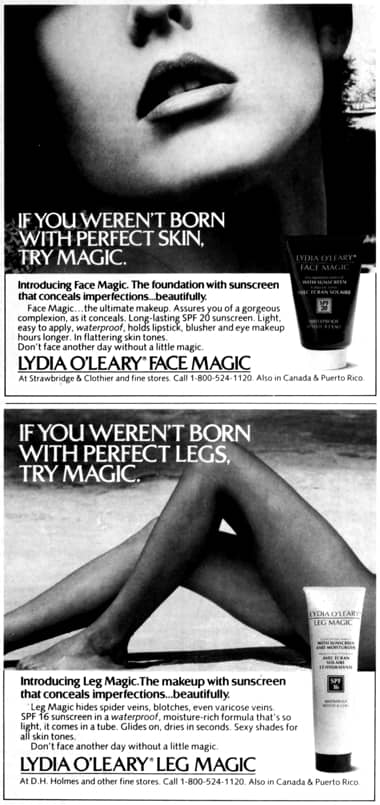
1989 Lydia O’Leary Face Magic and Leg Magic.
